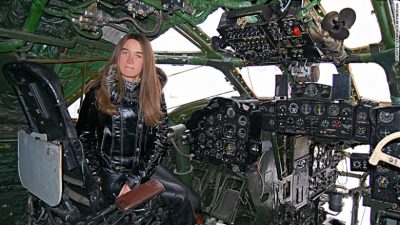For nearly three decades, an old Soviet airliner lay abandoned on a small airfield deep inside Siberia. Years of neglect under the harsh Siberian climate had reduced the Aeroflot Tupolev Tu-104A to little more than a decaying wreck. Until Maria Karmanova came into the picture.
On hearing about the old Tupolev rusting away at her local aerodrome at Berdsk, near Novosibirsk, she set herself the challenge of restoring it to its former glory.
Karmanova, 31, holds a doctorate in mathematics and works at the Sobolev Institute of Mathematics in Akademgorodok, one of Russia’s so-called “science cities.” She became an aviation enthusiast while making long air journeys to scientific conferences all over the world. Becoming keenly interested in old Soviet-made airplanes, she traveled around Russia, the former Soviet Union and beyond, in order to locate and fly them.

She soon ticked off aircraft such as the Lisunov Li-2, the Ilyushin Il-14, Il-18, Il-62 and IL-76, the Tupolev Tu-134 and Tu-154B-2, the Antonov An-12 as well as the Mil Mi-2 and Mi-17 helicopters. However, her most intense and fulfilling aviation adventure was awaiting near home: the derelict Tupolev Tu-104A at Berdsk.
Launched in the mid-1950s, the Tu-104 was briefly the world’s only operational jet airliner — a symbol of Soviet technological prowess at a time when Western aircraft manufacturers were still struggling to come up with a viable jet airliner. Capable of flying up to 115 passengers over distances of 1,500 nautical miles, it remained the workhorse of Soviet civilian aviation until well into the 1970s.
The aircraft at the center of this story (registration number CCCP-42382) was delivered to Soviet flag-carrier Aeroflot in 1958 and remained in service for 20 years.
First it flew international routes out of Moscow’s Vnukovo airport to destinations beyond the Iron Curtain. Later it was transferred to Pulkovo airport near St.Petersburg (Leningrad at the time) and then Novosibirsk Tolmachevo airport, before decommissioning in 1978 saw it shipped to Berdsk.
In retirement, it was initially used by the local aero club as a classroom to train skydivers and glider pilots, but progressively fell into a state of disrepair exacerbated by vandalism and equipment theft.
Karmanova heard about the Tupolev in 2009 and headed to Berdsk to make inquiries. The restoration project started to take shape and before long she was fully committed. The challenge was daunting. She had no experience of restoring or repairing aircraft, no idea what parts were needed or where they went, and no blueprints to work from.
Read more: http://edition.cnn.com
